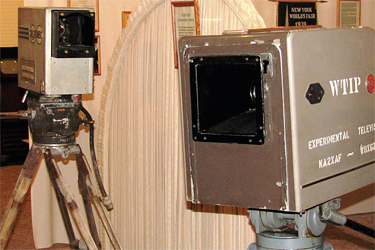Uncovering Television’s Past
HILLIARD, OHIO
Neither 3DTV nor Mobile DTV was being served, but the items that were on the agenda last month at the annual Early Television Foundation (ETF) convention drew as much or more attention from the crowd attending this eighth such gathering of TV historians.

These two 1939 vintage television cameras were on display at this year’s ETF conference. They may have seen service at the 1939-40 New York World’s Fair. The three-day event was organized by Steve McCoy, founder of the Early Television Museum, and attracted more than 100 persons from the United States and abroad.
McCoy explained that the event provides those with more than just a passing interest in the long path leading to today’s high-definition TV imagery and its influence on society with a chance to exchange information, meet each other face-to-face and show off items from their collections of television artifacts.
TELEVISION CAMERAS, 1939-STYLE
One of the event highlights was a display of two early iconoscope television cameras—one branded with the NBC-RCA logo (complete with sparks to indicate broadcasting) and another branded as experimental. It’s believed that both saw service at the 1939–1940 New York World’s Fair, an event marking the start of regular television broadcasting in the United States.
A very early RCA television field strength meter—used in the early field testing of television signals—was also on display, along with dozens of early U.S. and British TV receivers from that period.
Attendees also got to view a working example of an unusual 1965 vintage Mitsubishi color television receiver that did not use a color CRT, but rather three 9-inch monochrome tubes optically multiplexed together with dichroic mirrors to provide a full color NTSC image.
GETTING THE COLORS RIGHT
Part of the convention centers on the presentation of papers dealing with early television topics, with this year’s topics ranging from modern day replication of the color filters used in the 1940s/1950s CBS field sequential system to a cradle-to-grave history of a 1948 vintage television remote truck used by a small market broadcaster.
Collector and historian Cliff Benham described his ongoing experiences in finding suitable replacements for the red/blue/green Kodak Wratten filters used in the 1950 color receivers produced by CBS’s Hytron division.
“The original filters are now 60 years old and they’ve faded,” Benham said. “You can’t make a comparison because of the fading. The Wratten filters are also very, very expensive now. You would be spending $2,300 for the filter material [to refurbish a color wheel].”
Another hot topic was a progress report of ongoing work in the rebuilding of the 15GP22 cathode ray tube—the first production color CRT, and the one used by set manufacturers until larger tubes could be produced. The tubes haven’t been manufactured for some 50 years and most of those surviving have lost their vacuum due to leaks in the glass-to-metal construction used to fabricate them. A relatively large number of first-generation color receivers exist in the hands of collectors, but restoration to working condition is impossible without good 15GP22s.
The date for next year’s ETF convention has not been set yet.
Get the TV Tech Newsletter
The professional video industry's #1 source for news, trends and product and tech information. Sign up below.
James E. O’Neal has more than 50 years of experience in the broadcast arena, serving for nearly 37 years as a television broadcast engineer and, following his retirement from that field in 2005, moving into journalism as technology editor for TV Technology for almost the next decade. He continues to provide content for this publication, as well as sister publication Radio World, and others. He authored the chapter on HF shortwave radio for the 11th Edition of the NAB Engineering Handbook, and serves as editor-in-chief of the IEEE’s Broadcast Technology publication, and as associate editor of the SMPTE Motion Imaging Journal. He is a SMPTE Life Fellow, and a Life Member of the IEEE and the SBE.

